Aix-en-Provence 作者: 来源: 发布时间:2021-09-26
I.Population and Area
Region: Provence-Alpes-Côte d’Azur
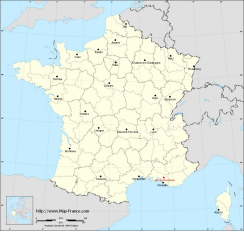
Department: Bouches-du-Rhône
Total Area: 186.08 km²
Population in 2017: 142 482
Population Density: 766 /km²
Location: The altitude of the city hall of Aix-en-Provence is approximately 200 meters. Its surface area is 186.08 km². The latitude and longitude of Villers are 43.528 degrees North and 5.448 degrees East. The towns and villages near Aix-en-Provence are: Le Tholonet (13100) at 5.30 km, Meyreuil (13590) at 5.86 km, Saint-Marc-Jaumegarde (13100) at 6.46 km, Beaurecueil (13100) at 7.99 km , Gardanne (13120) at 8.08 km.
Histogram of demographic change
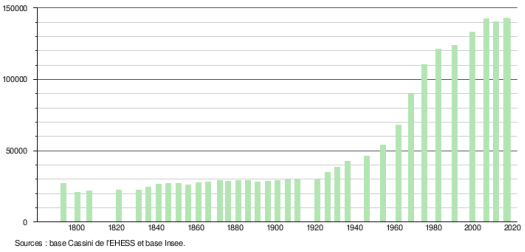
Sources : http://www.cartesfrance.fr/carte-france-ville/13001_Aix-en-Provence.html#mairie
II.Natural Geography
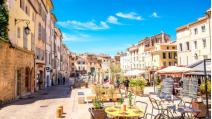
Geography: Aix-en-Provence is located 32 kilometers north of Marseille and the Mediterranean Sea, between the Sainte-Victoire massif in the east and the Trévaresse chain in the west. Aix-en-Provence is situated in the south of France, in a plain overlooking the Arc river, about a mile from the right bank of the river. The city slopes gently from north to south and the Montagne Sainte-Victoire can easily be seen to the east.
Climat: Aix's position in the south of France gives it a warm climate, though more extreme than Marseille due to the inland location. It has an average January temperature of 6 °C (43 °F) and a July average of 24 °C (75 °F). It has an average of 300 days of sunshine and only 91 days of rain. While it is partially protected from the Mistral, Aix still occasionally experiences the cooler and gusty conditions it brings.
Transport:
(1)A set of ancient roads radiate out from Aix to the surrounding countryside, the Pays d'Aix. There are also a large number of modern autoroutes connecting Aix to nearby towns. There are autoroutes northwards to Avignon and to the Luberon; southwards to Marseille; and eastwards to Aubagne and the Mediterranean coast of Provence; and to Nice and other towns on the French Riviera. Aix and Marseille are equidistant from the Marseille Provence Airport (MRS) at Marignane on the Etang de Berre which features domestic and international scheduled passenger service. There is another airport at Les Milles, which is mostly used by general aviation. There is a frequent bus shuttle service from the main bus station in Aix which also serves the nearby TGV station at l'Arbois, in the middle of the countryside about 10 miles (16 km) from Aix.
(2)At Aix, the line from Paris branches to Marseille and Nice; it takes about 3 hours to get from Paris to Aix by TGV. Aix also has a railway station near the centre, Gare d'Aix-en-Provence, with connections to Marseille, Pertuis and Briançon in the French Alps. A frequent and rapid shuttle bus service for commuters operates between the bus station in Aix and Marseille. There are many other long distance and local buses from the bus station. The city also offers a "city pass" available in 24, 48, and 72-hour packages for visiting tourists.The "pass tourisitque" is offered at the Aix-en-Provence Tourist Office, the Atelier de Cézanne, and the official Aix tourism website.
(3)In the town itself, there is an inexpensive municipal bus service, including a dial-a-bus service ("proxibus"), a park-and-ride service and tiny electrified buses for those with mobility problems. Those are six seater vehicles that circulate at a speed of 10 mph (16.09 km/h).The central old town of Aix is for the most part pedestrianised. There are large underground and overground parking structures placed at regular intervals on the "boulevard exterieur", the predominantly one-way ring road that encircles the old town. Access to the old town is by a series of often narrow one-way streets that can be confusing to navigate for the uninitiated.
(4)As in many other French cities, a short-term bicycle hire scheme nicknamed V'Hello, free for trips of less than half an hour, has recently been put in place by the town council: and has been popular with tourists. As well as overland routes, two "rivers" flow through Aix, the Arc and the Torse, but neither of which can remotely be described as navigable.
III.Economy
In 2017, the total fiscal expenditure in Aix-en-Provence was 195.99 million euros, the total fiscal revenue was 22.204 million euros, and the total debt was 127.3339 million euros.
In 2014, the per capita monthly net income of Aix-en-Provence was 2,868 Euros, among which senior staff was 4,632 Euros, which was higher than the French average (4,141 Euros); ordinary workers was 1,911 Euros, which was also higher than the French average (1,637 Euros).
unemployment rate (%): 8.5 (2018)
Average employment income (€):2868 net per month,34 420 per year(2014)
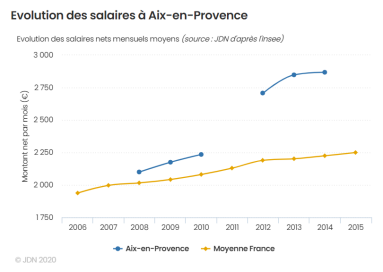
Evolution of average monthly net wages
Sources :
http://www.journaldunet.com/business/salaire/aix-en-provence/ville-13001
https://www.ceicdata.com/en/france/unemployment-by-region-and-zone/unemployment-rate-zone-sa-aixenprovence
IV.Industrial Characterisitics
Industries formerly included flour-milling, the manufacture of confectionery, iron-ware, hats, matches and the extraction of olive oil.
Current economic activities include:
(1)Tourism
(2)Entertainment, particularly opera and dance.
(3)The semiconductor and electronics industry in Rousset, to the south of Mont St Victoire, specializing in microchip technology for credit cards.
(4)Education and research. In Aix the University of Aix-Marseille specializes in the humanities, law and economics.
(5)The computer software industry.
(6)The manufacture of santons, traditional hand-crafted figurines, often associated with provencal Christmas creches.
(7)The manufacture of olive oil.
(8)The manufacture of calissons, a lozenge-shaped confection made from almonds, orange peel, sugar, and crystallized melon.
(9)Viticulture: the local Appellation d'Origine Contrôlée is Coteaux d'Aix-en-Provence AOC, with many vineyards between Aix and the River Durance to the north.Grape varieties include grenache, syrah, cabernet sauvignon, and notably vermentino.
(10)Chocolate: the well known Chocolaterie de Puyricard is situated in the hills to the north of Aix.
The airline Twin Jet has its head office in Aix-en-Provence. In 2018, its operating income was €27,136,000 and its net profit was €21,000.
V.Attractions
1.The Cours Mirabeau
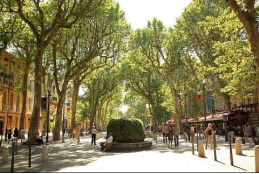
Introdcution: The Cours Mirabeau is a wide thoroughfare, planted with double rows of plane trees, bordered by fine houses and decorated by fountains. It follows the line of the old city wall, and divides the town into two sections. The new town extends to the south and west; the old town, with its narrow, irregular streets and its old mansions dating from the 16th, 17th and 18th centuries, lies to the north. Situated on this avenue, which is lined on one side with banks and on the other with cafés, is the Deux Garçons, the most famous brasserie in Aix. Built in 1792, it was frequented by the likes of Paul Cézanne, Émile Zola and Ernest Hemingway.
History: From 1646 onwards, rich locals started moving into the Mazarin quarter, built by Michele Mazzarino (1605 - 1648), known as "Michel Mazarin", the Dominican who was appointed Archbishop of Aix-en-Provence in 1645 by Pope Innocent X. Mazzarino had been professor of theology at the College of Saint Thomas, the future Pontifical University of Saint Thomas Aquinas, Angelicum in Rome, and Master of the Sacred Palace under Pope Urban VIII in 1642. Mazzarino was also the brother of Giulio Mazzarino, known as "Jules Mazarin" who served as chief minister under Louis XIV of France.In 1650, the Parliament of Aix-en-Provence commissioned the building of a thoroughfare for carts where there was a crumbled rampart.[1] The idea was for it to become the new place of dalliance for Aix dwellers, instead of the place des Prêcheurs. The thoroughfare cost 100,000 pounds, and was paid for by property buyers, the town (15,000 pounds), Provence communes (20,000 livres) and Louis, Duke of Vendôme.
2.The Cathedral of the Holy Saviour (Aix Cathedral)
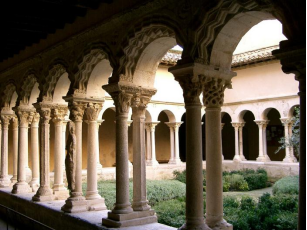
Introduction: The Cathedral of the Holy Saviour (Aix Cathedral) is situated to the north in the medieval part of Aix. Built on the site of a former Roman forum and an adjacent basilica, it contains a mixture of all styles from the 5th to the 17th century, including a richly decorated portal in the Gothic style with doors elaborately carved in walnut. The interior contains 16th-century tapestries, a 15th-century triptych, depicting King René and his wife on the side panels, as well as a Merovingian baptistery, its Renaissance dome supported by original Roman columns. The archbishop's palace (Palais de l'Archêveché) and a Romanesque cloister adjoin the cathedral on its south side.The Archbishopric of Aix is now shared with Arles.
Origin of the cathedral: The cathedral is located on the route of the Roman road, the Via Aurelia. A fragment of a Roman wall and the columns of the baptistery seem to be the origin of the legend that the church was built on top of a Roman temple dedicated to Apollo. The historian Pitton (1668) claimed that the temple had been dedicated to a sun god, basing his claim upon the discovery of the leg of a statue uncovered at the site. According to the Christian tradition, the first church on the site was founded by Saint Maximinus of Aix, who arrived in Provence from Bethany, a village near Jerusalem, with Mary Magdalene on a boat belonging to Lazarus. Maximin built a modest chapel on the site of the present cathedral and dedicated it to the Holy Saviour (le Saint Sauveur). During the invasion of the Saracens in the 8th and 9th centuries, the original chapel of Saint-Sauveur was destroyed.
3.Place de l'Hôtel de Ville
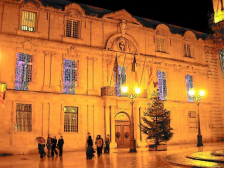
The Aix-en-Provence Town Hall (Hôtel de Ville), a building in the classical style of the middle of the 17th century, looks onto a picturesque square (Place de l'Hôtel de Ville). It contains some fine woodwork and tapestries. At its side rises a handsome clock-tower erected in 1510. Also on the Place de l'Hôtel de Ville is the former Corn Exchange (1759–1761) (Halle de Grains). This ornately decorated 18th-century building was designed by the Vallon brothers. Nearby are the remarkable thermal springs, containing lime and carbonic acid, that first drew the Romans to Aix and gave it the name Aquae Sextiae. A spa was built in 1705 near the remains of the ancient Roman baths of Sextius.
4.Fountains
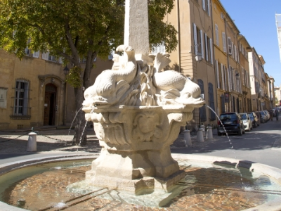
Introduction: Aix is often referred to as the city of a thousand fountains.In the late 19th century, the canal du Verdon and the Zola Dam allowed water to run in the basins of the fountains of the city. At first, these fountains were made for its practicality; the Fountain of the Nine Cannons by Laurent Vallon, for example, was originally a fountain where herds would drink while migrating, while the Fountain of Hot Water (a moss-covered fountain nicknamed Moussue) runs hot waters of the Bagniers spring.The fountains later became stylistic and ornamental. The La Rotonde fountain at the heart of the city is no doubt the most imposing one in Aix-en-Provence. Constructed in 1860, it is flanked by three statues depicting Justice, Agriculture and Fine Arts – the town’s main activities. In the heart of the Mazarin quarter stands the Fountain of the Four Dolphins, by sculptor Jean-Claude Rambot in1667. It features four dolphins supporting an obelisk, with a baroque motif hinting at the Italian design influence on the Aix nobility during that period.
Among the most notable are the 17th-century Fontaine des Quatre Dauphins (Fountain of the Four Dolphins) in the Quartier Mazarin, designed by Jean-Claude Rambot, and three of the fountains down the central Cours Mirabeau: At the top, a 19th-century fountain depicts the "good king" René holding the Muscat grapes that he introduced to Provence in the 15th century; halfway down is a natural hot water fountain (34 °C), covered in moss, dating back to the Romans; and at the bottom at la Rotonde, the hub of modern Aix, stands a monumental fountain from 1860 beneath three giant statues representing art, justice and agriculture. In the older part of Aix, there are also fountains of note in the Place d'Albertas and the Place des Trois-Ormeaux.
5.Museums and Libraries
Aix has several museums and galleries:
Le Musée du Vieil Aix (Museum of Old Aix), housed in two period "hôtels particuliers" and devoted to the history and provencal heritage of Aix.
Le Musée de Tapisseries (Tapestry Museum), housed in the Archbishop's Palace and with a collection of tapestries and furniture from the 17th and 18th centuries.
Le Musée Granet, a museum devoted to painting, sculpture and the archeology of Aix. It recently underwent significant restoration and reorganization, prior to the international exhibition in 2006 marking the centenary of Cézanne's death. Due to lack of space, the large archeological collection, including many recent discoveries, will be displayed in a new museum, still in the planning stages. The museum contains major paintings by Jean-Dominique Ingres (among which the monumental "Jupiter and Thetis"), an authentic self-portrait by Rembrandt and works by Anthony van Dyck, Paul Cézanne, Alberto Giacometti and Nicolas de Staël. In June 2011, the first part of the collection of the Fondation Jean et Suzanne Planque opened at the Musée Granet, containing over 180 artworks. This legacy of the Swiss painter, dealer and art collector Jean Planque, a personal friend of Pablo Picasso, has been donated to the city for an initial period of 15 years. The collection contains over 300 works of art, including paintings and drawings by Degas, Renoir. Gauguin, Monet, Cézanne, Van Gogh, Picasso, Pierre Bonnard, Paul Klee, Fernand Léger, Giacometti and Dubuffet. The full collection will be housed in a specially constructed annex in the Chapelle des Pénitents Blancs, situated nearby: the expected opening is in 2013.
VI.History
Aix (Aquae Sextiae) was founded in 123 BC by the Roman consul Sextius Calvinus, who gave his name to its springs, following the destruction of the nearby Gallic oppidum at Entremont. In 102 BC its vicinity was the scene of the Battle of Aquae Sextiae, where the Romans under Gaius Marius defeated the Ambrones and Teutones,with mass suicides among the captured women, which passed into Roman legends of Germanic heroism.
In the 4th century AD it became the metropolis of Narbonensis Secunda. It was occupied by the Visigoths in 477. In the succeeding century, the town was repeatedly plundered by the Franks and Lombards, and was occupied by the Saracens in 731 and by Charles Martel in 737. Aix, which during the Middle Ages was the capital of Provence, did not reach its zenith until after the 12th century, when, under the houses of Barcelona/Aragon and Anjou, it became an artistic centre and seat of learning.
Aix passed to the crown of France with the rest of Provence in 1487, and in 1501 Louis XII established there the parliament of Provence, which existed until 1789. In the 17th and 18th centuries, the town was the seat of the Intendance of Provence.Current archeological excavations in the Ville des Tours, a medieval suburb of Aix, have unearthed the remains of a Roman amphitheatre. A deposit of fossil bones from the Upper Continental Miocene gave rise to a Christian dragon legend.
VII.Other information
Aix-en-Provence is the city where Paul Cézanne 22 (1839-1906) spent his life.Paul Cézanne (January 19, 1839-October 22, 1906) was a famous French painter whose style was between Impressionism and Cubism. His works laid the foundation for the conversion of the artistic concept of the 19th century to the artistic style of the 20th century.
VIII.Contact information
Address of Aix-en-Provence town hall:
Mairie d'Aix-en-Provence
Place de l'Hôtel-de-Ville
CS 30715
13100 Aix-en-Provence
Phone number: 04 42 91 90 00
Fax: 04 42 91 94 92
Mail: http://www.mairie-aixenprovence.fr/Ecrire-aux-services
Website: http://www.mairie-aixenprovence.fr
Mayor : Maryse Joissains-Masini (Mandate : 2014-2020)
Sources : http://www.cartesfrance.fr/carte-france-ville/13001_Aix-en-Provence.html#mairie
